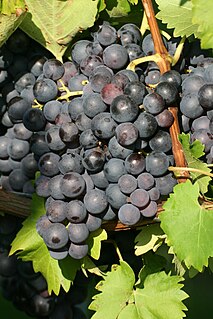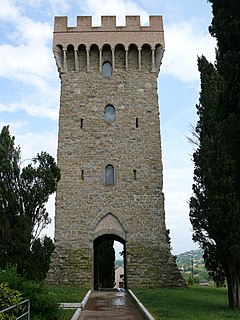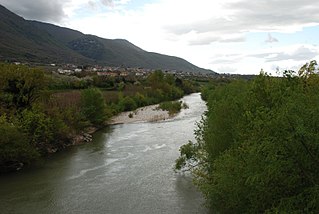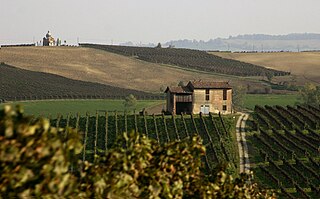
Trollinger, Schiava, or Vernatsch, is a red German/Italian wine grape variety that was likely first originally cultivated in the wine regions of South Tyrol and Trentino, but today is almost exclusively cultivated on steep, sunny locations in the Württemberg wine region of Baden-Württemberg. It is primarily known under the synonyms Trollinger in Germany, Vernatsch in South Tyrol and Schiava in other Italian regions. As a table grape the variety is sometimes known as Black Hamburg, which is commonly confused with the similar synonym for Black Muscat—a variety that is actually a cross of Trollinger and Muscat of Alexandria.

Lizzano is a comune of 10,175 inhabitants (2013) in the province of Taranto in the Apulia region of southeast Italy.

Leverano is a town and comune in the province of Lecce in the southeastern part of the Apulia region of south-east Italy. It is bounded by the comuni of Arnesano, Carmiano, Copertino, Nardò and Veglie.

Capalbio is a comune (municipality) in the Province of Grosseto in Tuscany region of Italy, located about 150 kilometres (93 mi) south of Florence and about 45 kilometres (28 mi) southeast of Grosseto. Capalbio borders the following municipalities: Manciano, Montalto di Castro, Orbetello.

Torgiano is a comune (municipality) in the Province of Perugia in the Italian region Umbria, located about 10 km southeast of Perugia.

Solopaca is a comune (municipality) in the Province of Benevento in the Italian region Campania, located about 45 kilometres (28 mi) northeast of Naples and about 20 kilometres (12 mi) northwest of Benevento. As of 31 December 2004, it had a population of 4,134 and an area of 31.0 square kilometres (12.0 sq mi).
Greco is an Italian wine grape that may be of Greek origin. The name relates to both white (Greco bianco) and black (Greco nero) grape varieties. While there is more land area dedicated to Greco nero, the Greco bianco is the grape most commonly referred to by "Greco". In the Campania region it is used to produce the Denominazione di Origine Controllata e Garantita (DOCG) wine Greco di Tufo. In Calabria, it is used to make the Denominazione di Origine Controllata (DOC) wine Greco di Bianco. The name "Greco" is sometimes used as a synonym for several varieties of supposed Greek origins-most notably Trebbiano.
Verdeca is a white Italian wine grape variety that is primarily grown in the Colli Piacentini region of Emilia-Romagna in central Italy and Apulia in southern Italy where ampelographers believe that the grape may have originated. In Apulia, it is one of the main grapes in the Denominazione di origine controllata wines of Locorotondo DOC and Martina Franca DOC along with Bianco d'Alessano. In Campania, it is grown on the slopes of Mount Vesuvius where it used as a blending variety with Falanghina, Coda di volpe and Greco in both the white wines and the sweet dessert wine of the region, Lacryma Christi. It is also a minor component used in the some vermouth production.
Bombino bianco is a white Italian wine grape variety planted primarily along Italy's Adriatic coast line, most notably in Apulia. The vine is prone to high yields and often produces neutral flavor wines. The grape is known under many synonyms throughout Italy including Debit and Pagadebit, names which came from the grape's reputation for being a high yielding and reliable crop for vineyard owners to grow that would assure them that on each vintage they could pay off their debts.
Perricone is a red Italian wine grape variety that is grown in Sicily. In the late 20th century there was around 1000 hectares/2,500 acres of the grape planted throughout the island. According to wine expert Oz Clarke in Sicily Perricone is used to make full bodied, deeply colored, highly alcoholic wines.
Abrusco is a red Italian wine grape variety grown primarily in the Tuscany region where it is a minor blending component permitted in the wines of Chianti. The grape has long history in the region and was mentioned in 1600, under its synonyms Abrostino and Colore, in the posthumously published work by Italian agronomist Giovan Vettorio Soderini Trattato della coltivazione delle viti, e del frutto che se ne può cavare. There Soderini notes that the grape was often used to add deeper, more red color to Tuscan wines.

The Colli Piacentini is an Italian wine region located at the western end of Emilia-Romagna. In 1967, it was given the Denominazione di origine controllata (DOC) quality designation. Within its boundaries are several smaller DOCs including Colli Piacentini Gutturnio, Monterosso Val D'Arda DOC, Trebbianino Val Trebbia DOC and Val Nur del Colli Piacentini DOC. The region has a long history of winemaking with fossilized vine roots and grape seeds excavated from the region showing viticulture taking place as early as 2000 BC. In Roman times, Julius Caesar's father-in-law Lucius Calpurnius Piso Caesoninus, grew grapes in the Piacenza hills.
Pomino is a village belongs to the municipality of Rufina, in the province of Florence, region Tuscany. The village of Pomino is 7,36 kilometers far from the same town of Rufina to whom it belongs. The locality of Pomino rises 585 meters above sea level and the population counts 228 inhabitants.

Pecorino is a white Italian wine grape variety that grows in the Marche, Abruzzo, Tuscany, Umbria and Lazio regions of Italy. Ampelographers believe that the grape is likely native to Marche, where the soil destined for this cultivation increases every year. This grape variety is used to produce the DOCG wines, like the Offida Pecorino DOCG, and the DOC wines, like the Falerio dei Colli Ascolani, the Colli Maceratesi and the Falerio dei Colli Ascolani.
Pascale di Cagliari is a red Italian wine grape variety that is grown in Sardinia.
Ortrugo is a white Italian wine grape variety that is grown in the Piacenza hills of the Emilia-Romagna region of north central Italy. Here the grape is often blended with Malvasia in the DOC white wines of the area. According to wine expert Oz Clarke, the grape has moderate acidity with high alcohol potential and often contributes a deep yellow color to the wine. In some regions the grape is used in slightly sparkling frizzante and fully sparkling spumante wines.

Nosiola is a white Italian wine grape variety that is grown in the Trentino region north of Lake Garda in the Valle dei Laghi. Here it is used in varietal Denominazione di origine controllata (DOC) wines and as a blending component in wines such as Sorni Bianco from Trento. It is also used to produce a dessert wine in the Vin Santo style from grapes that have been allowed to dry out prior to fermentation.
Mantonico bianco is a white Italian wine grape variety that is grown in the Calabria region of southern Italy. Ampelographers believe that the grape is likely of Greek origins and was transported to southern Italy by ancient Greek settlers. Though the variety has a long history in Calabria, its numbers have been slowly declining with 1100 hectares/2700 acres planted in the region by the end of the 20th century.

Abruzzo (Abruzzi) is an Italian wine region located in the mountainous central Italian region of Abruzzo along the Adriatic Sea. It is bordered by the Molise wine region to the south, Marche to the north and Lazio to the west. Abruzzo's rugged terrain, 65% of which is mountainous, help to isolate the region from the winemaking influence of the ancient Romans and Etruscans in Tuscany but the area has had a long history of wine production.
Abbuoto is a red Italian wine grape variety that is grown primarily in the Lazio region of central Italy. Historically the grape was believed to be responsible for the Ancient Roman wine Caecubum that was praised by writers such as Pliny the Elder and Horace but historians and wine experts such as Jancis Robinson and Julia Harding note that connection is likely erroneous.










